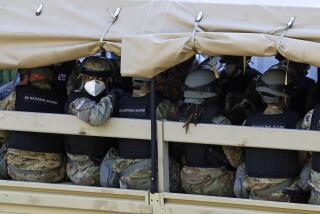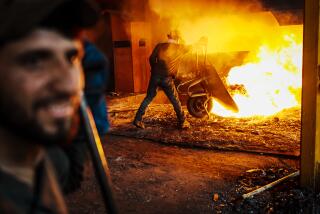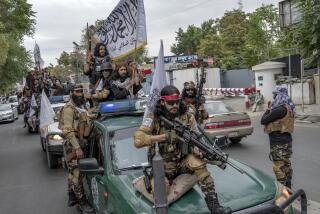U.S. plans to train Afghan militias
WASHINGTON — Confronting the prospect of failure after seven years in Afghanistan, the U.S. military is crafting a new strategy that is likely to expand the power and reach of that country’s tribal militias while relying less on the increasingly troubled central government.
Under that approach, U.S. forces would scale back combat operations to focus more on training Afghan government forces and tribal militias. The plan is controversial because it could extend the influence of warlords while undermining the government of President Hamid Karzai in Kabul, the capital.
The strategy also could set up a hair-trigger rivalry between national security units and the improved tribal forces, proponents acknowledge.
The U.S. military’s willingness to consider such risks reflects the growing worry about worsening conditions in Afghanistan. Until recently, the military would not have considered a move to bolster tribal militias, but, with relatively few troops available, military leaders believe only a new approach to the war can stanch the spreading violence.
“There has been very, very tough fighting this year, and it will be tougher next year unless we adjust,” Adm. Michael G. Mullen, chairman of the Joint Chiefs of Staff, told reporters Thursday.
Supporters contend that the dangers are offset by the prospect that well-trained tribal forces could help improve local security, undercut the insurgency and strengthen ties between rural areas and the central government.
“My bottom line is that this is clearly something we should do,” said a senior military officer, who was one of several who requested anonymity in describing strategy reviews because they were still underway.
By focusing on tribal militias and local security, the approach resembles the U.S. campaign in Iraq, where former Sunni insurgents are paid to guard their neighborhoods. But American officers emphasize that they are not planning to rely on a troop buildup similar to the one used in Iraq -- a topic of debate and commentary during the intensifying U.S. presidential campaign -- in Afghanistan.
Frustrated with Kabul
The new approach also reflects increasing frustration among U.S. and allied commanders with Afghanistan’s central government, which they believe has proved too weak to exert any meaningful influence outside the capital, especially in the country’s mountainous reaches.
Although Karzai several years ago declared that the era of warlordism was over and offered several warlords influential posts in the central government, they remain extremely powerful forces in the country. Many enjoy great influence in their home provinces, with some fielding private militias or gaining wealth from the opium trade.
Any broad effort to train tribal militias probably would have U.S. military forces working with Taliban sympathizers. But Defense Secretary Robert M. Gates, who is in Budapest, Hungary, to discuss the Afghanistan war with North Atlantic Treaty Organization defense ministers, said Thursday that the U.S. would be open to reconciling with the Taliban.
“There has to be ultimately, and I’ll underscore ultimately, reconciliation as part of a political outcome to this,” Gates said. “That’s ultimately the exit strategy for all of us.”
The new Afghanistan strategy is being crafted as new intelligence assessments conclude that the nation is spiraling downward in part because of the government’s shortcomings and widespread corruption. Those findings, contained in an upcoming U.S. National Intelligence Estimate, pose new concerns for American forces in Afghanistan, which have reported record casualties in 2007 and 2008.
The impending strategy shift is emerging from reviews set in motion this year and now nearing completion. The Pentagon and the White House are conducting such reviews, and U.S. Central Command, the military headquarters in charge of U.S. forces in the Middle East, is crafting its own recommendations.
Results of the White House review, conducted under Army Lt. Gen. Douglas E. Lute, deputy national security advisor for Iraq and Afghanistan, are weeks away, an administration official said.
The military reviews, one ordered by Mullen and the other by Gen. David H. Petraeus, the incoming head of Central Command, may be more significant because they could guide options presented to the next administration.
“My whole focus is on how to get this right,” Mullen said, “not just for the next few months, but for the foreseeable future.”
There are more than 30,000 U.S. troops in Afghanistan, far fewer than the 146,000 in Iraq. Military officials hope to send as many as 15,000 new troops in 2009, but some members of the Joint Chiefs have insisted that no additional forces should be deployed until a new strategy is in place.
A particularly acute need is for new military trainers for regular Afghan forces and the militias, as part of the U.S. push to improve local security.
The new Pentagon plan would expand the number of military trainers in Afghanistan by giving combat troops added responsibilities. Currently, most units are assigned either to a combat or training role. Mullen has advocated a hybrid role for most units.
The shift would have the effect of de-emphasizing combat operations against militant targets. Some experts have said those offensives amount to a fruitless game of whack-a-mole and distract from the more crucial training mission.
The Joint Chiefs of Staff has approved the hybrid proposal, officers said. But supporters of the local approach in Afghanistan said the task is likely to be far more complicated there than it was in Iraq.
Part of the reason the hyper-local strategy in Iraq was successful in decreasing violence was because the U.S. was able to offer employment and a measure of local power to tribal minorities alienated from the Shiite Muslim-led government.
In Afghanistan, however, tribes in the restless south and east are mostly Pashtun, the same ethnicity as President Karzai.
“The Sunnis in Iraq were disenfranchised, so we knew what motivated them,” a military official said. “The Pashtuns in Afghanistan are not disenfranchised, so the same tools won’t work.”
‘A hybrid mission’
In part the proposed shift reflects the new reality in Afghanistan. Units sent there this year and charged with training have found themselves fighting militants. The 2nd Battalion, 7th Marine Regiment, went to southern Afghanistan to train security forces but regularly ended up in combat.
“No one is looking at this as a schoolhouse job,” the military official said. “They have to do combat as well. It is almost a hybrid mission.”
The change in direction would also help shift the military’s focus to working with village and district leaders. In the Pentagon, growing numbers of officers have come to the conclusion that the military is too reliant on the relatively weak central government.
“There is a local level that we really have to work hard on,” the senior official said.
Counterinsurgency experts said focusing more units on training and working with a wider variety of forces, including militias, represent a needed shift.
Current operations in Afghanistan and Pakistan are focused too much on disrupting militants, said Andrew Krepinevich, executive director for the Center for Strategic and Budgetary Assessments, a Washington think tank.
Krepinevich said some special operation forces in Afghanistan have trained local militias, to good effect.
--
More to Read
Sign up for Essential California
The most important California stories and recommendations in your inbox every morning.
You may occasionally receive promotional content from the Los Angeles Times.










